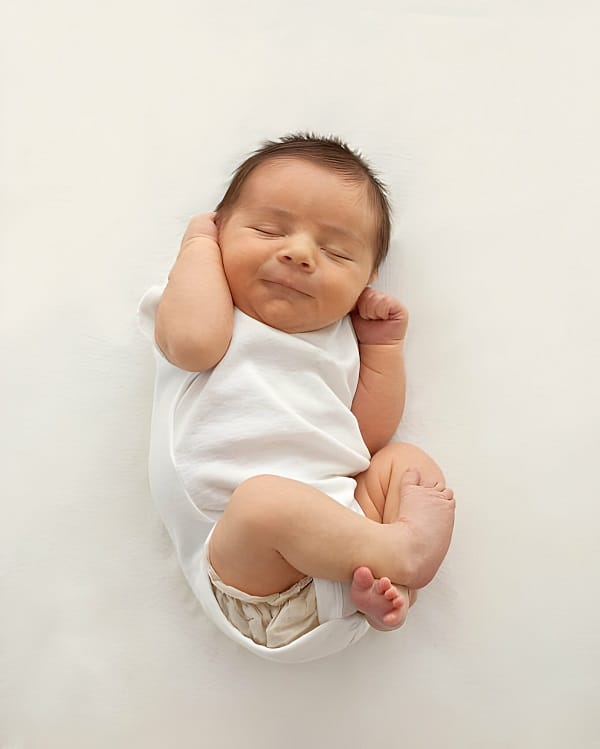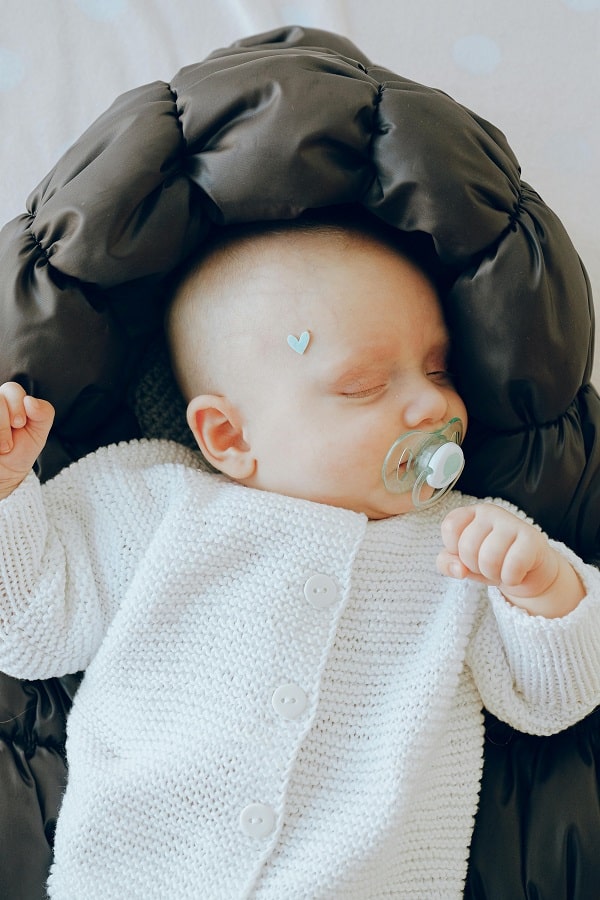Last Updated on January 1, 2025
Babies often sleep with their arms up due to the Moro reflex, a natural startle reflex present at birth. This instinctive movement can make them feel secure and comfortable. Additionally, sleeping in this “hands-up” position helps keep them cool and can be a sign of their developing motor skills.
Observing a baby’s sleep patterns can be both fascinating and puzzling for new parents. Among the myriad cute but curious behaviors, one that often garners attention is why babies sleep with their arms up. This distinctive pose, sometimes referred to as the “starfish” position, is not only adorable but is also rich with developmental and physiological significance.

The Moro Reflex
The primary reason behind this phenomenon is the Moro reflex. Also known as the startle reflex, it is an involuntary response that newborns exhibit when they feel a sense of falling or when they’re startled by a loud sound or sudden movement. The reflex is characterized by the baby spreading their arms to the sides, pulling the arms back in, and then usually crying for a few seconds. This reflex is present from birth and typically fades around 4 to 6 months of age.
The Moro reflex plays a crucial role in the developmental stages of a baby. It is considered a sign of a baby’s healthy neurological development. When babies sleep with their arms up, it’s essentially a mild expression of this reflex, indicating their nervous system is developing appropriately.
Read More – Strata Financing Solutions: The Key to Financial Freedom in Real Estate
The Comfort and Security of the Womb
Another perspective on why babies sleep with their arms up relates to their recent transition from the womb. In the womb, space is limited, and babies often position their limbs close to their bodies or above their heads. This “hands-up” sleeping position could be a continuation of the womb experience, where they felt most secure and comfortable.
Temperature Regulation
Sleeping with arms up also aids in regulating the baby’s body temperature. Babies are not as efficient at regulating their body temperature as adults. The open-arm position allows air to circulate the body, helping to keep the baby cool and prevent overheating, which is a risk factor for Sudden Infant Death Syndrome (SIDS).
Development of Motor Skills
The “arms-up” position is also indicative of the baby’s developing motor skills. As infants grow, they start to gain more control over their movements. Sleeping with their arms up or moving their limbs freely during sleep is part of exploring these new motor skills. It’s a sign that they are starting to experiment with movement and understand how their bodies function.
Sign of a Deep Sleep
Interestingly, when babies sleep with their arms up, it often indicates they are in a deep sleep phase. During REM (Rapid Eye Movement) sleep, babies are more likely to display active movements, including having their arms up. REM sleep is crucial for the baby’s brain development, as it’s believed to play a significant role in processing and storing new information.
Comfort and Self-Soothing
For some babies, sleeping with their arms up is a way of self-soothing. Just as adults have preferred sleep positions that make them feel comfortable, babies may find the “arms-up” position comforting. It gives them a sense of freedom and security, potentially making it easier for them to settle and fall back to sleep if they wake up during the night.
Read More – Top Benefits of Using Tinted Eyebrow Gel: Why It’s a Must-Have in Your Beauty Routine
When to Be Concerned
While the “arms-up” sleeping position is normal and beneficial for most babies, parents need to observe their child’s overall sleep patterns and behaviors. Consistent discomfort, difficulty breathing, or not showing typical developmental progress should prompt a consultation with a healthcare provider. However, the “arms-up” position in itself is rarely a cause for concern.

FAQs
Why Do Babies Sleep With Their Arms Up?
Babies often sleep with their arms up due to the Moro reflex, a natural startle response that makes them feel secure. This position can also help regulate their temperature and provide comfort, mimicking the snugness they experienced in the womb.
Why do babies lift their arms up while sleeping?
Babies lift their arms up while sleeping as part of the Moro reflex, which is an involuntary reaction to feeling startled or falling. It’s a normal part of development that shows their nervous system is functioning correctly.
Why babies keep their arms up?
Babies keep their arms up to self-soothe and maintain comfort during sleep. This position allows for better air circulation, helping with temperature regulation, and is a leftover instinct from the womb, where space was constrained, making it a familiar and comforting posture.
What does sleeping with your arms above your head mean?
Sleeping with arms above the head, often seen in babies, indicates a natural, comfortable sleeping position that helps regulate body temperature, facilitates easy breathing, and may signify deep, restful sleep phases. It’s a sign of relaxation and comfort in their sleeping environment.
When can I stop worrying about SIDS?
Parents can feel more at ease about SIDS after their baby turns one year old, as the risk significantly decreases. Most SIDS cases occur between 1 to 4 months of age. Continuing safe sleep practices, like placing babies on their backs to sleep, can further reduce risk.
Read More – The Unscented Revolution: Embracing Fragrance-Free Essentials for Sensitive Care
Conclusion
The sight of a baby sleeping with their arms up can bring a smile to anyone’s face. Understanding the reasons behind this behavior—from the Moro reflex to temperature regulation and comfort—can reassure parents that their baby is developing healthily and naturally. It’s one of the many small wonders of early childhood development, highlighting the complexity and adaptability of the human body from such a young age. As always, parents should remain observant and consult healthcare professionals with any concerns about their baby’s health and development, ensuring that the baby continues to grow and thrive in the safest and most loving environment possible.

